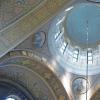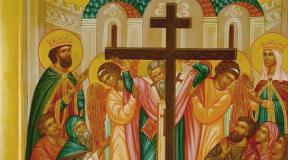Pokrovsky Cathedral on Red Square. Who built the St. Basil's Cathedral? Major versions
The Cathedral of the Intercession of the Most Holy Theotokos on the Moat (St. Basil's Cathedral) is one of the most significant monuments of ancient Russian architecture of the 16th century. The cathedral was erected in 1555-1561. at the behest of Tsar Ivan the Terrible in honor of the conquest of the Kazan kingdom.
The central church was consecrated in the name of the Protection of the Most Holy Theotokos. Four churches - Three Patriarchs of Constantinople, Cyprian and Justina, Alexander Svirsky and Gregory of Armenia - were consecrated in the name of the saints, on the day of whose memory important events of the campaign took place. Other important events of Russian spiritual life in the second half of the 16th century were also reflected in the program of consecrations of the cathedral's churches: the appearance in the Vyatka lands of the new image of Nicholas the Wonderworker, the glorification of the Monks Varlaam of Khutynsky and Alexander Svirsky. The Eastern Church is dedicated to the main dogma of the Christian faith - the Holy Trinity. The Western Church of the Entry of the Lord into Jerusalem connects the cathedral with the image of the Heavenly City.
The Cathedral of the Intercession has unique wall paintings, an impressive collection of Old Russian icon painting and masterpieces of church and applied art. The ensemble of ten churches with full iconostases is unique, the interiors of which reflect the four-century history of the temple.
Cathedral of the Intercession of the Virgin, which is on the moat - this is the name of this temple on Red Square. But among the people it is more often called St. Basil's Cathedral. There are also those who remember the name Trinity Cathedral, which existed in the 16th century. This temple, 65 meters high, closes the perspective of Bolshaya Dmitrovka. And before that, before the construction of high buildings in Moscow at the turn of the 19th and 20th centuries, the cathedral was visible in the perspective of large sections of Pokrovka, Tverskaya, Myasnitskaya, Petrovka. It was rightfully called the main temple of the Moscow posad.
The cathedral was built in 1555-1561 next to the Kremlin moat. One can say, on the edge of the ditch, hence its name - that on the ditch. Tsar Ivan the Terrible became the customer for the construction of the cathedral. The cathedral was built as a memory of the capture of the capital of the Kazan Khanate, the city of Kazan. The siege of Kazan began on August 15, 1552 and ended with an assault on the Feast of the Intercession. It was decided to build a cathedral with 9 thrones, or 9 churches, in honor of those holidays, which coincided with important moments of the siege and storming of the city.
The central, hipped-roofed temple is the Protection of the Virgin. Around him are churches: from the east - the Trinity, the western temple - the Entrance to Jerusalem, Nicholas Velikoretsky, Cyprian and Justina (later rededicated in the name of Adrian and Natalia), Paul, Alexander and John of Constantinople (later - John the Merciful), Alexander Svirsky, Barlaam Khutynsky, Gregory of Armenian. Services in each of the churches were performed only on their patronal feasts. All churches, except for the central one, Pokrovskaya, are completed with colored patterned onion domes. They appeared at the end of the 16th century instead of the old helmet-shaped domes. All churches stand on a high basement that unites them, like on a pedestal. All churches have circular aisles. In the 16th century, the outer gallery around the temples was open, and the treatment of walls at the gallery level in all churches looked like a wide strip of arches and cornices, visually uniting the entire building. Today, this wall treatment can be seen in the interior of the gallery, at the southeast corner of the cathedral. Due to the Moscow climatic conditions, in the middle of the 17th century, the gallery was covered with vaults, and stone tents were erected over the porches. At the same time, for the first time, bright decorative painting appeared on the facades of the cathedral. A little earlier, in the 1670s, a hipped-roof bell tower was built instead of the belfry.
In 1588, a low one-domed church was added to the north-western part of the gallery over the grave of St. Basil the Blessed (1469 - 1552). During his lifetime, Vasily was famous as a holy fool and a seer. During the funeral, the coffin of Vasily was carried by Ivan the Terrible himself with the boyars, and the funeral service was performed by Metropolitan Macarius. Over time, Vasily became one of the Moscow saints beloved by the people. The service in the Vasilievskaya church was performed every day, therefore the entire cathedral was called St. Basil's Cathedral.
At the beginning of the 18th century, there were already 18 thrones in the Intercession Cathedral. New thrones were consecrated in the premises of the basement.
By the beginning of the 19th century, long trading rows of small shops, taverns and taverns stood around the cathedral, fencing it off from Red Square. During the restoration of the city after a fire in 1812, it was decided to clear the territory, and in 1817 the architect Osip Bove built a retaining wall from the west, south and east. The cathedral received a wrought-iron fence that has survived to this day.
It is believed that the cathedral was built by the masters Barma and Postnik. Some researchers believe that this was one person, Postnik Yakovlev, nicknamed Barma. Other buildings of Postnik Yakovlev are also known, created by him after the construction of the cathedral. But none of them bears resemblance to the Intercession Cathedral either in details or in technology. There are many architectural forms in the architecture of the cathedral that only a person who worked and studied in Western Europe could create. But such a person is not yet known to us.
In 1923 it was decided to create a museum in the cathedral. Services in St. Basil's Church continued until 1929. The last rector of the cathedral, Fr. John Vostorgov, was shot by a court sentence in 1918, and in 2000 he was canonized. Since 1991, the cathedral has been in the joint use of the museum and the Orthodox Church.
Since 1931, a monument to Minin and Pozharsky (1818, sculptor Ivan Martos) has been standing in the fence of the cathedral. The monument was moved to the cathedral from the middle of Red Square, where it began to interfere with parades and mass demonstrations that were held twice a year, on May 1 and November 7.
The Cathedral of the Intercession of the Most Holy Theotokos on the Moat, popularly known as the Cathedral of St. Basil the Blessed, is included in the list of the main attractions of Moscow and Russia as a whole.
A brief history of St. Basil's Cathedral
In the 16th century on the territory of the modern temple there was a wooden Trinity Church, which was also referred to as "Jerusalem".
The construction of St. Basil's Cathedral began in 1555 thanks to a vow given by Ivan the Terrible. The tsar solemnly promised that in case of a successful completion of the Kazan campaign, he would build an amazing temple in memory of this event.
After each successful battle, a small wooden church was built next to the Trinity Church in honor of the saint who was honored on the day of the victorious duel.
After the triumphant return of the army to the capital, Ivan the Terrible decided to erect a large structure of brick and white stone on the site of these churches - the Cathedral of the Intercession of the Most Holy Theotokos on the Moat.
The name is explained simply: it was on the Feast of the Intercession that Kazan was taken. As for the moat, there used to be a defensive moat that stretched along the Kremlin from the side of the main square. Now its place is taken by the Soviet necropolis and Lenin's Mausoleum.

The construction of the Intercession Cathedral was completed in 1561. In 1588, an extension was added in honor of the Moscow holy fool Vasily the Blessed.
Muscovites were very fond of Saint Basil, whose prophecies tended to come true, therefore the temple in honor of the Intercession of the Mother of God is still known under the name of the blessed one, although only one of the boundaries of the cathedral is dedicated to him.
The Cathedral of St. Basil the Blessed in Moscow was repeatedly completed and restored, came under threat of demolition, plundered and rebuilt. After the revolution and until 1991, it functioned exclusively as a museum. Now the cathedral on Red Square is under the joint use of the State Historical Museum and the Russian Orthodox Church.
Who built St. Basil's Cathedral
It is not known for certain who was the architect of the Intercession Cathedral and how many there were. One of the versions claims that its architects are some Postnik and Barma. However, the latest research is based on the fact that the creator of the project, Ivan Yakovlevich Barma, is nicknamed Postnik. There is also a third version about the architect of the Cathedral of St. Basil the Blessed in Moscow, perhaps it was an unknown Italian master, which explains the combination of elements of primordial Russian and Western European architecture of the Renaissance.

Cathedral architecture on Red Square
If you look at the Cathedral of St. Basil the Blessed from above, the view from above will remind you of an eight-pointed star, which in Orthodoxy is a symbol of the Virgin.
The temples are united by two galleries. From the west, two porches are attached to the cathedral, to which stairs of white stone lead. From the northeast is the tenth side-altar - the Church of St. Basil the Blessed, in whose honor the popularly accepted name of the most famous Moscow temple was established. The eleventh side-altar is a bell tower crowned with an octagonal tent in the southeast of the building.
Thus, it is not difficult to draw a conclusion about the number of domes on the Cathedral of St. Basil the Blessed: there are eleven of them.

St. Basil's Cathedral: interesting facts
- The ancient legend about the builders of St. Basil's Cathedral says that when the cathedral was built, the architects Postnik and Barma, by order of Ivan the Terrible, were blinded so that they could no longer build anything so beautiful.
- The decoration of St. Basil's Cathedral inside under Ivan IV was much easier than it is now. Unique frescoes on the walls were created in the 17th century. Externally, the temple complex also looked completely different. There were 25 domes, their color was golden, and the shape was not bulbous, but helmet-shaped. The walls were originally white. The building acquired its present appearance during the 16th, 17th and even 19th centuries.
- The height of the Cathedral of the Intercession on the Moat is 61 meters, which was very, very high for the 16th century.
- Until the end of the 16th century, caches were located in the niches of the lower floor of the Intercession Church until the end of the 16th century, in which the royal treasury was kept, as well as the property of the richest townspeople.
- In 1812, Napoleon plundered the values \u200b\u200bof the Cathedral of the Intercession on the Moat, and tried to blow up the building itself, however, according to legend, the fuses leading to the explosives died out due to the sudden onset of rain.
- There is also a legend from Soviet times, according to which Stalin himself saved the Intercession Cathedral in Moscow from being demolished. Looking at the model of Red Square brought by Kaganovich, from which the removable model of the cathedral was removed, Joseph Vissarionovich exclaimed: “Lazarus, put it back!”, Thus making it clear that he didn’t like the idea of \u200b\u200bclearing a place for military parades.
Opening hours of the Museum "Pokrovsky Cathedral"
As a museum, St. Basil's Cathedral in Moscow is open daily.
Museum opening hours:
- may, September – October: from 11:00 to 18:00;
- june – August: from 10:00 to 19:00;
- november – April: 11:00 to 17:00.
Important information!The first Wednesday of every month is a cleaning day.
At temperatures below -15 ° C, museum opening hours are reduced.
On Sundays at 10.00, as well as on the days of patronal holidays, services are held in the cathedral.
St. Basil's Cathedral is a side-chapel of the Cathedral of the Intercession of the Most Holy Theotokos and is one of the eight churches that surround the central cathedral. Although the official name of the shrine of the Russian Orthodox Church is the Cathedral of the Intercession, for believers and those interested in religious architectural monuments, it is known as the Cathedral of St. Basil the Blessed. You can understand the symbolism of the temple and its significance for Russia and the Russian people by examining the history of the emergence of a unique cathedral and churches with it.
Prerequisites for the construction of the cathedral
St. Basil's Cathedral is not the first construction of a religious shrine that arose in Moscow in the 16th century. Initially, wooden churches were erected in honor of saints or Orthodox holidays that fall on the day of any military event on the Kazan land, when Tsar Ivan the Terrible was fighting the Tatar invasion. One of the great battles that took place on October 2, 1552, ended with a complete victory over the Kazan Khanate and the annexation of the city's lands to the Orthodox city of Moscow.
On this date (October 1) there is a religious holiday of the Protection of the Most Holy Theotokos, which gave rise to the construction of a cathedral in memory of the final victory, which was consecrated in honor of the Protection of the Virgin. But the day of the campaign itself and the victory coincided with another Orthodox day - the veneration of Saints Cyprian and Justina.
By order of Ivan the Terrible, it was decided to combine all the camp churches that had been erected on Red Square earlier and the new temple into a cathedral, which should be made of stone. But upon returning to Moscow, a wooden cathedral with seven side-chapels was built. It was consecrated in the name of the Protection of the Most Holy Theotokos. Only a year later, the wooden buildings were dismantled and the construction of a stone church began, but it still had nothing to do with the name of St. Basil the Blessed.
The reasons for the foundation of the temple
St. Basil's Cathedral, among other buildings of the Intercession Church, appeared only in 1588 and became the 9th church of a unique monument of the Orthodox faith. The reasons for the construction of the Cathedral of St. Basil the Blessed were the events that took place during the reign of Ivan Vasilyevich the Terrible and his son Fyodor Ivanovich. According to legends, Vasily was a holy fool and collected alms in Red Square, from which he fed and lived. He dressed in rags or went completely without clothes even in the bitter frost. He wore chains as a symbol of repentance and sacrifice for Christ. He had the gift of healing and foresight, as evidenced by various legends or descriptions of his life.
Ivan the Terrible treated the holy fool with special respect and after his death, the date of which is twofold (1552 or 1557), permission was given to bury the body near the walls of the Intercession Church. According to the chronicle documents, several years after the death of Basil, several healings were recorded from his relics, which was the reason to erect a reliquary of precious metal with expensive stones over the grave of Basil the Blessed and build a church, which was consecrated in honor of this saint.
Tsar Fyodor Ivanovich set the date for honoring the name of St. Basil the Blessed - August 2, the day of the miraculous healing.
Unlike other churches that were part of the ensemble of temples of the Intercession of the Most Holy Theotokos, St. Basil's Cathedral was an independent structure and had a separate entrance.
The reasons for the construction of a multi-sided temple are two versions:
- The Intercession Cathedral was supposed to become a semblance of the Vlakhensky monastery, in which the miracle of the Intercession of the Most Holy Theotokos was revealed. It has a seven-tower shape. The Cathedral of the Intercession in Moscow was supposed to commemorate the ideology of the state of the time that Moscow was the Third Rome.
- The idea of \u200b\u200ba multi-sided cathedral was proposed by Metropolitan Macarius, who wanted to build another city in the center of Moscow, symbolizing Jerusalem, so to speak, a city within a city, which also echoed the concept of the Third Rome. The Cathedral of the Intercession of the Most Holy Theotokos is a Heavenly Jerusalem and it must be indivisible, therefore all buildings were erected on a single foundation.
Regardless of what idea became the reason for the creation of a religious shrine, it is the object of unique Orthodox architecture, which still inspires admiration among people.
How the cathedral was built: versions
There are several versions about the construction of the cathedral, the ensemble of buildings of which includes the Cathedral of St. Basil the Blessed, who is the architect of the project and how their fate developed after the end of the work.
- One version suggests that Ivan the Terrible invited an architect from Pskov to implement his idea. His name was Postnik Yakovlev, but the people called him Barma. This indicates that one person created the project of the Intercession Church and supervised its construction.
- The second version boils down to the fact that Postnik and Barma are two different people who jointly brought the idea of \u200b\u200ba multi-aisled cathedral to life.
- The third version has nothing to do with Postnik or Barma. It is assumed that the author of the project was a European architect, presumably an Italian. The style of the temple is very similar to the motives of the Moscow Kremlin, which was built by the European architect. But there is no documentary confirmation of the version.
Changes in architecture and design
The modern look of St. Basil's Cathedral (the official name is the Cathedral of the Intercession of the Most Holy Theotokos) is in many ways different from the cathedral built in the middle of the 16th century. Changes in style and architecture took place due to frequent fires and the desire to make the cathedral more convenient to use.
Initially, the appearance of all buildings was strict, but immediately elegant. The walls were painted with frescoes and designs imitating brickwork to give the cathedral a greater grandeur.
The churches did not have porches. The Cathedral of St. Basil the Blessed was not listed on the project and was not built simultaneously with other side-altars. The bell tower stood separately and had a different shape.
The central tent-roofed cathedral, surrounded by small churches in honor of the significant dates of the Kazan campaign, was a kind of memorial monument and did not require a special style.
Until 1588, the cathedral did not have a single heated room, which excluded the possibility of conducting services in the cold season. St. Basil's Cathedral became the first heated object, which attracted pilgrims and believers all year round to the Moscow shrine. The temple worked around the clock and received wandering people for the night. This moment, perhaps, served as the fact that the cathedral became known precisely by the name of the Cathedral of St. Basil the Blessed, and not the Protection of the Most Holy Theotokos.
Modifications of the 16th century
Due to frequent fires in Moscow, the wooden tops of the churches burned down. Once again, it was decided to change the shape of the heads of the temple. They were made curly and covered with iron.

From the inside, all the premises of the cathedral were united by labyrinths of passages, allowing the servants to move freely from one room to another. The area of \u200b\u200bthe churches themselves was very small, which was compared to cells. On major holidays, services were held on Red Square, because no church could accommodate everyone.
How the temple changed in the 17th century
Significant changes took place only in the 17th century. A tent-roofed bell tower was added to the ensemble of the cathedral in 1670. The cathedral received a new painting in the form of a motley ornament. Several more churches were added to the cathedral of eight side-altars and the Cathedral of St. Basil the Blessed, which had to be removed from Red Square due to their dilapidation. According to the inventory of dilapidations in 1688, there is information that 20 thrones were attached to the Intercession Cathedral.
In addition to the relocation of existing churches, in 1672 a chapel was added over the grave of another Moscow holy fool named John, who died in 1589 and was buried on the territory of the cathedral.
By 1680, the cathedral was significantly renewed due to the fact that the open-type wooden galleries were replaced by brick ones with a closed top, which made it possible to move around the perimeter of the cathedral in any weather and protected the churches and St. Basil's Cathedral from destruction by fires. Outside and inside, the walls of the gallery and other rooms were painted with herbal ornaments, which made the religious shrine more elegant.
Inscriptions about the date of completion of the restoration (1683) were applied to ceramic tiles and placed on the walls of the cathedral.
Fire and recovery
The Trinity fire in Moscow in 1737 did not bypass the temple, which burned down almost 100%. But it was decided to restore the temple. The work on the interior and architecture of the cathedral was entrusted to Ivan Michurin, who drew up a detailed plan and description of the Intercession Cathedral at the time of restoration.
New repairs and changes in the architecture of the cathedral were carried out in 1784-1786 with the assistance of Catherine II, who allocated impressive funds for the renovation of the cathedral.
The Cathedral of St. Basil the Blessed, which received a covered porch due to the abolition of the throne of Theodosievskaya Church from the northern facade of the Intercession Cathedral, also fell under the alteration.
During this period, the exterior of the cathedral had nothing to do with the modern look, because street trading was not prohibited. Bookstores and Yablochny Row completely covered the walls of the cathedral. Only Alexander the First solved the problem of inappropriate buildings and transformed the area around the cathedral with the help of wild stone and an iron grate.
XIX - early XX century and their influence
The history of the XIX-XX centuries left its mark on the cathedral. First, Napoleon attempted to assassinate the shrine, because he was struck by a unique building and wanted to destroy the Orthodox core of Russia. Attempts to blow up all the churches and the Cathedral of St. Basil the Blessed were in vain, but the church utensils were stolen, the premises were desecrated. This led to a new stage of restoration work in the cathedral, which made it possible to preserve the shrine to this day.

The next restoration work was carried out in the temple in 1890 and in 1912:
- strengthened the floors;
- renovated the cathedral sacristy, decorating its windows with colored stained-glass windows.
Foundation of the museum in the XIX-XX centuries
The beginning of the 20th century was marked for the Intercession Cathedral by the fact that in 1918 it was taken under the protection of the state as a historical object of national and world scale. Services in some churches have completely stopped. The process of transition of the cathedral to the status of a museum began.
In 1923, it was decided to house a historical and architectural museum in the premises under the leadership of E. I. Silin, who was a research assistant at the State Historical Museum.

In 1928, the Cathedral of the Intercession of the Most Holy Theotokos (popularly, Basil the Blessed) received the status of a branch of the State Historical Museum, which has survived to this day.
Until 1949, research work was carried out in the cathedral, which opened underground manholes connecting the temple with the Kremlin. The functional significance of some rooms located in the basement of the cathedral was revealed.
Since 1991, St. Basil's Cathedral has been under the joint patronage of the State Historical Museum and the Russian Orthodox Church.
The current state of the temple

Today, the cathedral has been fully restored and works, combining the functions of a museum and a place for worship on Sundays and Easter.
In 2008, the Intercession Cathedral received the status of one of the seven wonders of Russia, and in 2017 entered the list of UNESCO World Heritage Sites, being a unique architectural monument and the pride of Russian Orthodoxy.

The Cathedral of St. Basil the Blessed, or the Cathedral of the Intercession of the Mother of God on the Moat, as its canonical full name sounds, was built on Red Square in 1555-1561. This cathedral is rightfully considered one of the main symbols not only of Moscow, but of the whole of Russia.
At the place where the cathedral is now adorned, in the 16th century there was a stone Trinity Church, “on the Moat”. There really was a defensive moat that stretched along the entire Kremlin wall along Red Square. This moat was filled only in 1813. Now in its place is the Soviet necropolis and the Mausoleum.
Ivan the Terrible, who personally led the army in the campaign to conquer the Kazan and Astrakhan kingdoms in 1552, vowed, in case of victory, to build a grandiose temple in Moscow on Red Square in memory of this. While the war was going on, in honor of each major victory, a small wooden church was erected next to the Trinity Church in honor of the saint on whose day the victory was won. When the Russian army returned to Moscow in triumph, Ivan the Terrible decided to replace the eight wooden churches that had been built, to erect one large, stone one - forever.

In 1552, blessed Basil was buried near the stone Trinity Church, who died on August 2 (according to other sources, he died not in 1552, but in 1551). Moscow's "Christ for the sake of the holy fool" Vasily was born in 1469 in the village of Yelokhovo, from his youth was endowed with the gift of clairvoyance; he predicted the terrible fire of Moscow in 1547, which destroyed almost the entire capital. The blessed one was honored and even feared by Ivan the Terrible. Legend has it that Vasily himself collected money in the floor for the future Intercession Church, brought it to Red Square and threw it over his right shoulder - a penny to a penny, a penny to a penny, and no one, even thieves, touched these coins. After the death of Basil the Blessed, he was buried in the cemetery at the Trinity Church (probably by order of the tsar), with great honors. And soon the grandiose construction of the new Intercession Cathedral began here, where the relics of Vasily were later transferred, on whose grave miraculous healings began to be performed.
There is a lot of controversy about the builder (or builders) of St. Basil's Cathedral. Traditionally, it was believed that Ivan the Terrible ordered the construction to the masters Barma and Postnik Yakovlev, but many researchers now agree that it was one person - Ivan Yakovlevich Barma, nicknamed Postnik.

Church of St. Basil the Blessed. Bishbois lithograph
There is a legend that after the construction, Grozny ordered the masters to be blinded so that they could no longer build anything like this, but this is nothing more than a legend, since the documents indicate that after the construction of the Cathedral of the Intercession on the Moat, Master Postnik "according to the Barma River" (t e., nicknamed Barma) built the Kazan Kremlin.

The ground around the Cathedral of St. Basil the Blessed seemed to be covered with felt, since barbers had been sitting around the temple for a long time. They cut their hair, but never removed it, so the layer of hair that had accumulated here over the years made it look like felt.
St. Basil's Cathedral consists of nine churches on one foundation. The central altar of the temple is dedicated to the feast of the Protection of the Mother of God. It was on this day that the wall of the Kazan fortress was destroyed by an explosion and the city was taken.

The idea of \u200b\u200bthe Intercession Cathedral is based on the apocalyptic symbolism of Heavenly Jerusalem. Eight chapters, located around the ninth central tent, in the plan form a geometric figure of two squares, combined at an angle of 45 degrees, in which it is easy to see an eight-pointed star.

The number 8 symbolizes the day of the Resurrection of Christ, which, according to the Hebrew calendar, was the eighth day, and the coming Kingdom of Heaven - the Kingdom of the "eighth century" (or "eighth kingdom"), which will come after the Second Coming of Christ - after the end of earthly history associated with the apocalyptic number 7.

The square expresses the firmness and constancy of faith and is a cosmic symbol of the Universe: its four equal sides mean four cardinal points, four winds of the Universe, four ends of the cross, four canonical Gospels, four apostles-evangelists, four equilateral walls of Heavenly Jerusalem. The combined squares symbolize the preaching of the Gospels to the four cardinal directions, that is, to the whole world.

The eight-pointed star - a reminder of the Star of Bethlehem, which showed the Magi the way to the Christ Child, the Savior of the world - symbolizes the entire Christian Church as a guiding star in human life to Heavenly Jerusalem. The eight-pointed star is also a symbol of the Most Holy Theotokos - the Lady of the Church and the Queen of Heaven: in Orthodox iconography, the Mother of God is depicted in a maforia (veil) with three eight-pointed stars on her shoulders and on her forehead as a sign of Her Eternal Virginity - before, during and after the Nativity of Christ.

There are only 10 domes. Nine domes over the temple (According to the number of thrones: Protection of the Virgin (center), Holy Trinity (east), Entrance to Jerusalem (west), St. Gregory of Armenia (north-west), Alexander Svirsky (south -east), Varlaam Khutynsky (south-west), John the Merciful (formerly John, Paul and Alexander of Constantinople) (north-east), Nicholas the Wonderworker Velikoretsky (south), Adrian and Natalia (formerly Cyprian and Justina) (north)) plus one dome above the bell tower. (In the old days, St. Basil's Cathedral had 25 domes representing the Lord and 24 elders sitting at His throne).

The cathedral consists of eight churches, the thrones of which are consecrated in honor of the holidays that fell on the days of the decisive battles for Kazan: Trinity, in honor of St. Nicholas the Wonderworker (in honor of his Velikoretskaya icon from Vyatka), Entrance to Jerusalem, in honor of the martyr. Adrian and Natalia (originally - in honor of St. Cyprian and Justina - October 2), St. John the Merciful (until XVIII - in honor of St. Paul, Alexander and John of Constantinople - November 6), Alexander Svirsky (April 17 and August 30), Varlaam Khutynsky (November 6 and 1st Friday of Peter's Lent), Gregory of Armenia (September 30 ).

All these eight churches (four axial, four smaller between them) are crowned with onion domes and are grouped around the ninth pillar-like church towering above them in honor of the Protection of the Mother of God, topped with a tent with a small dome. All nine churches are united by a common base, a bypass (originally open) gallery and internal vaulted passages.

In 1588, from the north-east, a side-altar was added to the cathedral, consecrated in honor of St. Basil the Blessed. The bell tower was added to the cathedral only in 1670.

The height of St. Basil's Cathedral is 65 meters. In 1737, the Intercession Church was badly damaged by fire and was restored, and the thrones of fifteen churches from Red Square were transferred under its vaults. In the second half of the 18th century, under Catherine II, the cathedral was reconstructed: 16 small chapters around the towers were demolished, retaining the eightfold symbolism in the base, and the hipped-roof bell tower was connected to the building of the cathedral. At the same time, the cathedral acquired a modern multi-colored color and became a real Moscow miracle.
According to legend, Napoleon wanted to transfer the Moscow miracle to Paris, and the horses of the French army were placed in the temple. The technology of that time turned out to be powerless in front of this task, and then, before the retreat of the French army, he ordered to blow up the temple together with the Kremlin. Muscovites tried to extinguish the lit fuses, and a sudden pouring downpour helped stop the explosion.

In 1929 the cathedral was closed and transferred to the Historical Museum. In 1936, Pyotr Dmitrievich Baranovsky was summoned and offered to take measurements of the Church of the Intercession on the Moat, so that it could be demolished. The temple, according to the authorities, interfered with the movement of cars on Red Square ... Baranovsky told officials that the demolition of the cathedral was madness and a crime, and promised to immediately commit suicide if this happens. After that, Baranovsky was immediately arrested. When he was released six months later, the cathedral continued to stand in its place ...

There are many legends about how the cathedral was preserved. The most popular is the story of how Kaganovich, presenting to Stalin a project for the reconstruction of Red Square for the convenience of holding parades and demonstrations, removed from the square a model of St. Basil's Cathedral, to which Stalin ordered him: "Lazar, put it in place!" It was as if this decided the fate of the unique monument ...
One way or another, but St. Basil's Cathedral, having survived all those who tried to destroy it, remained standing on Red Square. In 1923-1949, large-scale research was carried out there, which allowed to restore the original appearance of the gallery. In 1954-1955, the cathedral was painted "like a brick" again, as in the 16th century.
In the 70s, during the restoration, a spiral wooden staircase was found in the wall, along which visitors of the museum now get to the central church, where they can see a magnificent tent soaring into the sky, the most valuable iconostasis and walk through the narrow labyrinth of the inner gallery, completely painted with marvelous patterns.

In November 1990, the first all-night vigil and liturgy took place in the church, and at the consecration of the Kazan Cathedral its bells rang. On the patronal feast of the Intercession on October 13-14, a service is performed here.

A branch of the Historical Museum is located in the cathedral, and the flow of tourists there does not dry out. Since 1990, it has occasionally held services, but the rest of the time it is still a museum. There are 19 bells in the museum, which were cast in the distant 1547 by famous craftsmen. In addition to the bells in the cathedral, you will see a huge collection of weapons that Ivan the Terrible collected during his lifetime.




















